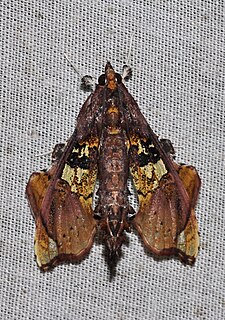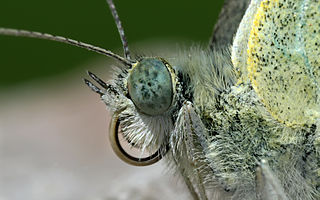
A pupa is the life stage of some insects undergoing transformation between immature and mature stages. The pupal stage is found only in holometabolous insects, those that undergo a complete metamorphosis, with four life stages: egg, larva, pupa, and imago. The processes of entering and completing the pupal stage are controlled by the insect's hormones, especially juvenile hormone, prothoracicotropic hormone, and ecdysone. The act of becoming a pupa is called pupation, and the act of emerging from the pupal case is called eclosion or emergence.

The Crambidae are the grass moth family of lepidopterans. They are variable in appearance, the nominal subfamily Crambinae taking up closely folded postures on grass stems where they are inconspicuous, while other subfamilies include brightly coloured and patterned insects which rest in wing-spread attitudes.

The Lasiocampidae are a family of moths also known as eggars, snout moths, or lappet moths. Over 2,000 species occur worldwide, and probably not all have been named or studied.

Liphyra brassolis, the moth butterfly, is a butterfly found in South Asia, Southeast Asia and Australia that belongs to the lycaenid family. The larvae are predatory and feed on ant larvae. This is one of the largest species of lycaenid butterflies. Several disjunct populations across its wide distribution range are considered as subspecies. Never a common butterfly, specimens of this species are highly prized by collectors.

Spilomelinae is a very species-rich subfamily of the lepidopteran family Crambidae, the crambid snout moths. With 4,132 described species in 340 genera worldwide, it is the most speciose group among pyraloids.

Omiodes continuatalis is a species of moth in the family Crambidae. It is endemic to the Hawaiian islands of Kauai, Oahu, Molokai, Maui, Lanai and Hawaii. It was first cited as possibly extinct by W.C. Gagné and Francis Gard Howarth in 1982. It was listed as extinct by the Hawaiʻi Biological Survey in 2002 and the IUCN in 2003, but was rediscovered later in 2003.

Diphthera festiva, the hieroglyphic moth, is a species of moth in the family Nolidae and is the only moth in its subfamily Diphtherinae. It is found in the tropical and subtropical areas of South America, Central America, North America, and the Caribbean. In North America, the species has a southeastern distribution from South Carolina west to Texas along the Gulf Coast. Strays have been recorded as far north as Michigan and Missouri. The wingspan is 37–48 mm (1.5–1.9 in). This species is occasionally considered a pest on soybeans. It was described by Johan Christian Fabricius in 1775.

Agrotera is a genus of snout moths in the subfamily Spilomelinae of the family Crambidae. It is the type genus of the tribe Agroterini and currently comprises 28 species distributed in the Afrotropical, Palearctic, Indomalayan and Australasian realm.
Hydropionea is a genus of moths of the family Crambidae. The 13 described species are distributed in Central and South America.
Laniifera is a genus of snout moths in the subfamily Spilomelinae of the family Crambidae. The genus was erected by George Hampson in 1899 with Pachynoa cycladesDruce, 1895 as type species.

Udea is a genus of snout moths in the subfamily Spilomelinae of the family Crambidae. The genus was erected by Achille Guenée in 1845. The currently known 214 species are present on all continents except Antarctica. About 41 species are native to Hawaii.

Terastia is a genus of snout moths in the subfamily Spilomelinae of the family Crambidae. It was described by Achille Guenée in 1854 with Terastia meticulosalis as type species. The genus is currently placed in the tribe Margaroniini, where it is closely related to the genera Agathodes and Liopasia.

The external morphology of Lepidoptera is the physiological structure of the bodies of insects belonging to the order Lepidoptera, also known as butterflies and moths. Lepidoptera are distinguished from other orders by the presence of scales on the external parts of the body and appendages, especially the wings. Butterflies and moths vary in size from microlepidoptera only a few millimetres long, to a wingspan of many inches such as the Atlas moth. Comprising over 160,000 described species, the Lepidoptera possess variations of the basic body structure which has evolved to gain advantages in adaptation and distribution.

Amyna axis, the eight-spot, is a moth of the family Noctuidae. The species was first described by Achille Guenée in 1852.
Omiodes antidoxa is a moth of the family Crambidae. It is endemic to the Hawaiian islands of Kauai and Oahu.
Scirpophaga flavidorsalis is a moth in the family Crambidae. It was described by George Hampson in 1919. It is found in Yunnan, China, India, Bhutan, Bangladesh, Thailand, western Malaysia, Java, the Philippines, New Guinea and Australia.
Scirpophaga nivella is a moth in the family Crambidae. It was described by Johan Christian Fabricius in 1794. It is found in southern Asia from the Indian Subcontinent in the west to southern China in the east, south to New Guinea and Australia, including New Caledonia and Fiji. Some sources have affixed the common name "sugarcane top borer" to it, despite it not being found in sugarcane, because they are confused with the species Scirpophaga excerptalis, which is an actual borer in the tops of sugarcane. Another newer common name that has been invented for these moths is "white rice borer".
Niphopyralis myrmecophila is a moth in the family Crambidae. It was described by Roepke in 1916. It is found in Indonesia (Java).
Wurthiini is a tribe of the species-rich subfamily Spilomelinae in the pyraloid moth family Crambidae.
Malickyella is a genus of snout moth in the species-rich subfamily Spilomelinae of the family Crambidae. The genus was described in 2010 by the German entomologists Wolfram Mey and Wolfgang Speidel based on material from South-East Asia. The four species of the genus are distributed in the lowland forests of the Indomalayan realm, stretching from the Indian state of Assam to the Philippines.













